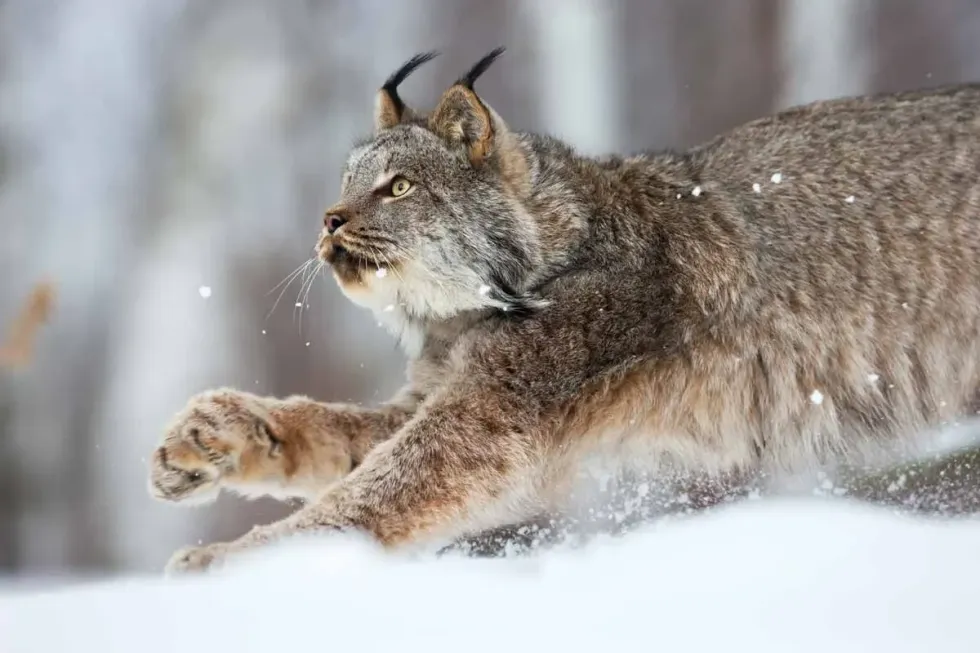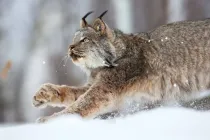Canada lynx, also known as Lynx canadensis, is a medium sized North American lynx that is found in the United States, Rocky Mountains and regions of Canada and Alaska and other boreal forests. They can be easily recognized by their long dense fur and black ear tufts.
Their primary prey is the snowshoe hare. They are generally active during the night and during the day; a lynx may stay in rough nests or shrubs.
There are no such predators of these animals, however the kittens may fall prey to other larger animals like boars and bears.
There have been instances of habitat loss by this species, because of human intervention. Depending on the season of the year and their habitat, unlike other lynx species, the color of their coat may change, from light brown to grey or black.
Their thick coat helps them to keep them warm in the cold weather. They are carnivores who feed on other smaller animals and may also eat birds.
If you are fascinated by Canada lynx, then you may want to read the following amazing facts about them. If you want to learn more about different animals, you can read up on the Balinese cat and the ocelot.
Canada Lynx Interesting Facts
What type of animal is a Canada Lynx?
The Canada lynx, also known as the Canadian lynx, is a medium-sized lynx that is found in the regions of North America.
What class of animal does a Canada Lynx belong to?
The Canada lynx belongs to the Mammalia group of animals.
How many Canada Lynx are there in the world?
There is no fixed number as to the Canada lynx populations. Primarily recognized as an endangered species because of their decreasing population, they no longer maintain that conservation status and have been classified as 'least concern' species by the IUCN.
Where does a Canada Lynx live?
The lynx habitat generally includes large deforested areas and dense boreal forests. They typically avoid open areas and find it difficult to survive in heavily logged areas or agricultural lands.
What is a Canada Lynx's habitat?
The Canada lynx habitat is generally the regions of Canada and Alaska, Blue Mountains, Cascade Range, southern Rocky Mountains, Great Lakes regions, and New England. Since 2019, they have also been reintroduced in the region of Colorado after they became extinct from that region in the 1970s.
Who do Canada Lynx live with?
They are solitary animals that sleep in the day and move at night in search of prey. They do not move in packs and maintain distance from human beings as well.
How long does a Canada Lynx live?
In the wild, the life span of this species is typically 14 years. However, in captivity, there have been cases where their life span has been found to exceed the typical 14 years and go as far as 26 years.
How do they reproduce?
March to early May is the mating season for this animal. Females reach their sexual maturity as early as 21 months, while males take a longer period of time of 33 months, to reach theirs.
Behavioral tendencies like urine marking or mating calls are portrayed by the male to tempt the females and increase the interaction between the two sexes. Before giving birth, the females usually make a sort of den, which may be inside thick bushes or shrubs.
The gestation period for a female lynx usually lasts for two to three months, after which a litter of one to eight kittens are born.
The birth occurs typically between the months of May to July. The newborn kittens are blind for the first 14 days and leave their mother after almost 10 months when the next breeding season starts.
What is their conservation status?
According to the International Union for Conservation of Nature and Natural Resources, the conservation status of this species is 'least concern' as per their stable population. In the year 2000, the U.S.
Fish and Wildlife Service marked their conservation status as an 'endangered' species in 14 states owing to their decrease in population figures.
The U.S Fish and Wildlife Service in 2005, marked six different states for the revival of their population, where there have been reports of lynx reproduction in the past two decades.
In 2018, the U.S Fish and Wildlife Service, reportedly declared that the lynx population no longer required any special protection in the United States and they were removed from the 'endangered' category.
Canada Lynx Fun Facts
What do Canada Lynx look like?

The Canadian lynx is a lean medium-shaped animal, which long, thick fur and sharp claws. Like all other lynx, they too have black tufts, 1.6 in (4 cm) in length, protruding from the tip of their ears which are lined with black fur.
Their hindlimbs are longer than the front limbs, which gives them a lean structure. Male lynx are generally heavier and longer than females.
Their fur is typically yellowish-brown in color, which is uniform throughout, with little or no marking, except on the underpart.
This helps them to mix well and hide from their prey in the snow of frosty regions. They have large broad paws covered with thick fur, which can spread up to 3.9 in (10 cm), which enables them to move easily on the soft snow.
How cute are they?
Yes, like other cats, they are also extremely cute. With their large paws and black-tipped tufts, they are sure to win the heart of any person who comes across them. One look at a Canada lynx kitten with its black ear tufts can melt the heart of any normal human being.
How do they communicate?
Canadian lynx communicate with the help of their ears, eyes, and nose. They also make calls to each other, especially during the season of mating. Mothers show their love and protection to their kittens through various actions like licking or nibbling.
How big is a Canada Lynx?
The length of a Canada lynx range between 29in - 42 in (73cm - 107 cm). They can be as tall as 19in – 22 in (48cm – 56 cm).
Males are usually larger and heavier in size than females. The disparity in physical proportions is almost zero to none, as they are designed naturally of that shape to feed on smaller prey. A Canadian lynx is shorter in size than the Eurasian lynx.
How fast can a Canada Lynx move?
The speed of a Canadian lynx generally ranges from 0.47mph – 0.91 mph (0.75km/h – 1.46 km/h), especially when they are trying to catch their prey. They are known to cover a distance of 5.0 mi - 5.6mi (8km - 9km) daily.
How much does a Canada Lynx weigh?
Because of the disparity in the sizes of the male and female lynx, females weigh less than males, with an average weight of 11 lb – 26 lb (5kg – 12 kg), while males weigh between 13lb – 37 lb (6kg – 17 kg). When a new kitten is being born, they generally weigh around 6.2oz.
- 8.3 oz (175g - 235 g).
What are their male and female names of the species?
There are no such specific different names for a male and female Canada lynx.
What would you call a baby Canada Lynx?
A group of baby Canada lynx is called a litter and individuals from a particular litter are called kittens.
What do they eat?
The primary diet of a Canadian lynx is the snowshoe hare. Snowshoes hares comprise as much as 35 - 97% of their diet.
Other parts of their diet include animals like red squirrels, ducks, grouse, moles, and young ungulates.
According to a study in Alaska, it has been found that there has been a gradual decrease in the population of red fox and caribou, pertaining to the Canada lynx who feed on them when the numbers of snowshoe hares are lower.
This species moves at night to hunt for their prey, snowshoe hares, which is their primary time to be active.
Are they dangerous?
No, a Canada lynx is not typically dangerous. They are not naturally aggressive and generally avoid human beings. However, if they feel threatened or cornered, they may even attack humans.
Would they make a good pet?
Yes, they can be a good pet, if properly trained. One should always remember that they are wild cats and therefore deal with them accordingly.
With proper nurture and attention, they can be trained to be kept around humans and other domestic animals. Eventually, they become quite affectionate with their owners as well. With adequate attention, space and understanding, they can be good pets.
Did you know...
Because of their large and broad feet, a Canada lynx, unlike other wild cats do not dig their feet into the snow. Their big feet allow them to distribute their weight evenly on the ground, and stay on top of the snow. For this reason, they can even hunt at high altitudes with deeper snow.
Just like other house cats, they too use the method of urinating, to mark their territories. There have been cases where they have been found to have territories of more than 700 square kilometers.
One of the rarest lynx to be found in the world is the 'blue lynx' which is a result of a genetic mutation. The earliest recorded case of a cat on the loose in the UK was when a Canada lynx was shot dead in 1904 after it attacked two dogs.
At that time, the animal was unidentified and was finally identified in a 2014 study. According to several estimates, the lynx was kept captive, probably as an exotic pet.
There is an uncanny synchronization between the snowshoe hare populations and the lynx populations. When there is a surge in the hare populations, a surge in the lynx populations has also been noticed according to various studies.
Is the Canada Lynx endangered?
The lynx Canadensis was listed as an endangered species in the regions of New Brunswick and Nova Scotia. It was initially declared to be a 'Threatened' species by the U.S Fish and Wildlife Service, however, later it was revoked, following the preservation measures taken by the United States to preserve their species.
The conservation status of Lynx canadensis is 'Least Concern' as of now. It was an endangered species for a very large period of time, owing to their killing for their fur.
Do people keep Canada Lynx as pets?
Yes, many people have ventured to keep an exotic animal as a pet. However, proper nurture, attention, and care are required for keeping them.
Their requirements differ from that of a domestic animal because they are wild cats and therefore the training that is applicable for a domestic animal, might not be in their case. With the right way, and at the right time, they can also be trained to live well with humans and other domestic animals.
Here at Kidadl, we have carefully created lots of interesting family-friendly animal facts for everyone to discover! Learn more about some other mammals including the striped polecat and the muskrat.
You can even occupy yourself at home by drawing one on our canada lynx coloring pages.










